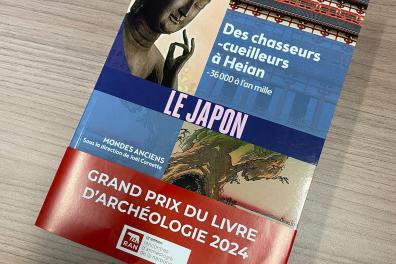Grand prix du livre d'archéologie 2024: Pierre-François Souyri and Laurent Nespoulous

In October 2023, in the Mondes anciens series published by Belin, Le Japon Des chasseurs-cueilleurs à Heian, the first comprehensive work in French (or any European language) on the history of the functioning of the very ancient societies of the Japanese archipelago from its settlement to the advent of the state.
The authors, Laurent Nespoulous and Pierre-François Souyri, have just been awarded the Grand Prix du livre d'archéologie 2024 at the recent Rencontres archéologiques de la Narbonnaise for this work.
Summary
Nearly 40,000 years ago, Japan was not yet the archipelago we know it to be: linked to the mainland, these lands of hostile relief and capricious climatic and geological conditions - some thirty volcanoes were active - welcomed the first humans, some ten thousand at most, from Korea, territories further south or even Siberia. Its longitudinal immensity had consequences for the development of societies, and in ancient times, several cultural spheres coexisted.
In the east and northeast, hunter-gatherers settled down and were among the first in the world to elaborate sophisticated pottery, which made the reputation of the Jômon culture, but they never engaged in the "Neolithic revolution". In contrast, the Yayoi culture in northwest Kyûshû introduced agriculture and flooded rice cultivation. Then, in Yamato, the first traces of a state appear, from which peripheral local societies escape for a long time, before Japan as a centralized state headed by an emperor, the tennô, suddenly emerges in the last third of the 7th century. The State of Codes that was then established represented a major moment in Japanese history: the institutions created at the turn of the 7th and 8th centuries were to endure, in multiple forms, until the 1870s.
Based on the results produced by Japanese archaeology, one of the most dynamic in the world, little-known iconography and unpublished maps, the authors trace an unconventional history of ancient Japan, from the origins of mankind in the archipelago until around the year 1000.
The authors
Trained as an archaeologist and former resident of the Maison franco-japonaise in Tôkyô, Laurent Nespoulous is head of the Japanese Studies Department at Inalco. He is interested in Japanese prehistory and protohistory, and is the author of numerous scientific and popular articles. With L. Laporte, J.-M. Large, C. Scarre and T. Steimer, he has recently published a two-volume work on Japanese prehistory and protohistory. Steimer, a two-volume sum on the Mégalithes dans le monde (2022).
Pierre François Souyri, a specialist in Japanese history, taught at Inalco, was director of studies at the École française d'Extrême-Orient, then director of the Maison franco-japonaise de Tôkyô, before being appointed to the University of Geneva. He has published numerous books, including Les Guerriers dans la rizière. La longue histoire des samouraïs (2021).